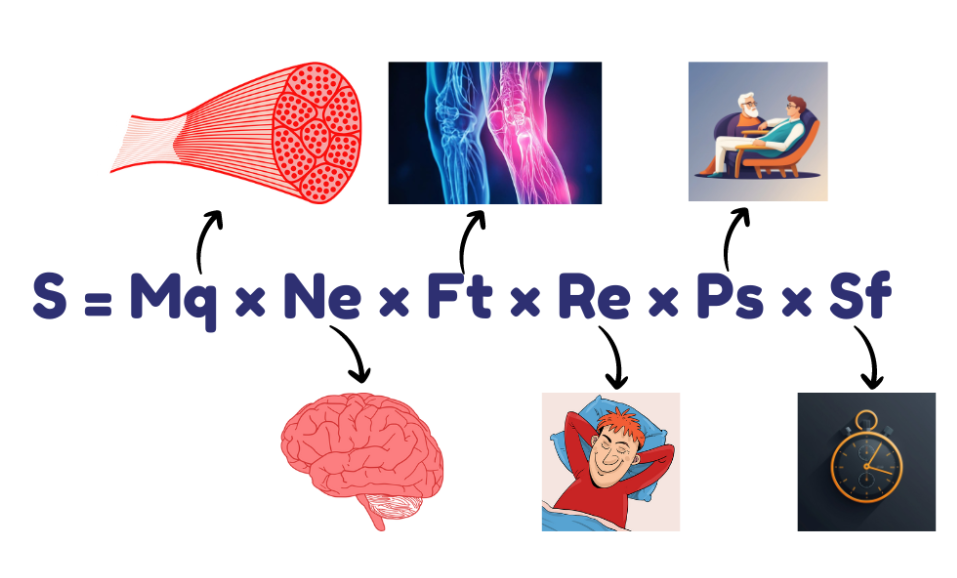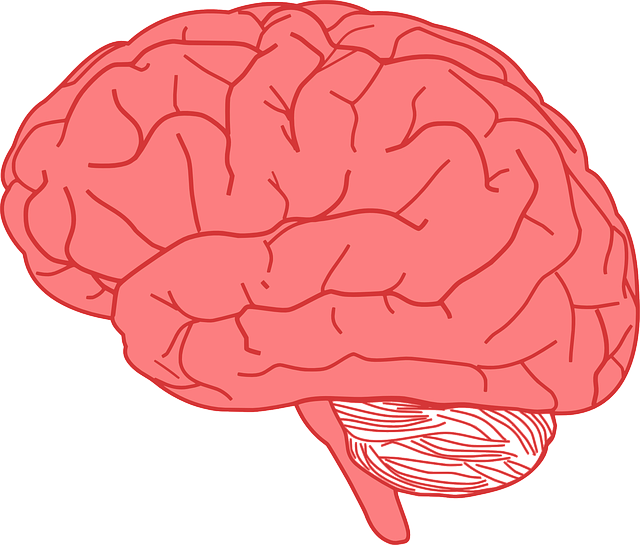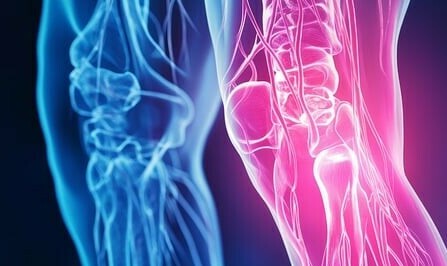Introducing the Gainz Equation: A Groundbreaking Discovery in Bro Science

I’ve got something truly revolutionary for you today—the Gainz Equation. It’s so groundbreaking that many bro scientists have told me I’m probably going to win the Nobel Prize in Bro Science for it. But in all seriousness, while I won’t be winning any actual Nobel Prizes for this, this equation is going to be incredibly valuable in helping you understand exactly what you need to do to maximize your muscle gains. Let’s dive in!
The Gainz Equation: What Is It?
At its core, the Gainz Equation is a conceptual tool designed to help you understand the key factors that contribute to muscle growth and strength. It’s not about crunching numbers like a mathematician; it’s about getting a clear picture of what drives progress in the gym and how you can optimize your training, nutrition, and recovery to get the best results.
Here’s what the Gainz Equation looks like:

S = Mq x Ne x Ft x Re x Ps x Sf
Where:
- S = Strength
- Mq = Muscle Qualities, including cross-sectional area (CSA) and myofibrillar density.
- Ne = Neuromuscular Efficiency, the ability of your nervous system to recruit and coordinate muscle fibers.
- Ft = Tendon Properties, such as stiffness and elasticity. It’s abbreviated Ft because tendons allow effective Force transmission from muscles to an external load.
- Re = Recovery Efficiency, covering sleep, nutrition, and other recovery practices.
- Ps = Psychological State, including motivation, focus, and mental resilience.
- Sf = Sustained Force, or your ability to maintain force production over time.
Breaking Down the Equation: Understanding the Variables
Let’s break down what each of these variables means and how they play a role in your journey to maximizing muscle gains.
1. Muscle Qualities (Mq)

Muscle quality is about the size and density of your muscles. This includes both sarcoplasmic hypertrophy (the increase in the fluid part of the muscle that stores glycogen) and myofibrillar hypertrophy (the increase in the muscle fibers that actually produce force). But it’s not just about muscle; tissue compression around the joints comes into play here too. Whether you’ve got a lot of muscle or a bit of extra padding, the compression of tissues—both muscle and fat—can contribute to strength by supporting your joints and adding stability during heavy lifts. I think of tissue compression as the ‘squish effect,’ because your tissues are being squished together around the joints. This effect becomes especially apparent when you transition from bulking to cutting, as you might notice a slight decrease in strength due to the reduction in tissue compression, even if your muscle mass remains intact. You can read more about muscle quality here.
2. Neuromuscular Efficiency (Ne)

This is all about how effectively your nervous system can recruit and coordinate muscle fibers. The better your neuromuscular efficiency, the more muscle fibers you can activate, leading to greater strength. Improving this involves practicing specific lifts, incorporating explosive movements, and focusing on developing better motor control.
3. Tendon Properties (Ft)

Tendons are more than just passive structures—they actively adapt to the types of stimulus they receive, much like muscles do. Depending on how you train, your tendons can become stiffer, which improves your ability to lift heavier weights, or more elastic, which is beneficial for explosive power. This means that by training in a specific way, you can actually enhance your tendons’ ability to contribute to greater strength, hypertrophy, and power. It’s an often overlooked aspect of training, but understanding tendon adaptation can give you a significant edge in your performance.
4. Recovery Efficiency (Re)

Recovery is where the magic happens. This variable covers everything from how well you sleep to how effectively you replenish your nutrients after a workout. It’s also where your hormonal environment comes into play—factors like testosterone, growth hormone, and cortisol levels can make a big difference in how quickly you recover and grow. Optimizing recovery means getting enough sleep, eating the right foods, and managing stress.
5. Psychological State (Ps)

Your mental game is just as important as your physical game. This variable represents your motivation, focus, and overall psychological resilience. The stronger your psychological state, the more consistent and intense your training will be, leading to better results over time.
6. Sustained Force (Sf)

Finally, sustained force is about your ability to maintain force production over time. This is where metabolic stress comes into play—high-rep sets, short rest intervals, and endurance-focused training all contribute to your ability to keep pushing through tough workouts. While metabolic stress is more directly related to hypertrophy than strength, it’s an important part of the equation for anyone looking to build muscle.
Why the Gainz Equation Matters
The Gainz Equation isn’t just a fun concept—it’s a valuable tool for understanding what you need to focus on to get the best results in the gym. By keeping these variables in mind, you can tailor your training, nutrition, and recovery to maximize your gains. Whether you’re looking to build muscle, increase strength, or just improve your overall fitness, the Gainz Equation provides a clear roadmap to success.
Next Steps: Now that you’ve got a handle on the Gainz Equation, the next article in this series will dive into Muscle Quality (Mq) and the “Squish Effect,” exploring how these factors influence your strength and hypertrophy. And if you’re excited to put these concepts into practice, keep an eye out for my upcoming app, designed to help you optimize every aspect of your training.
David Crowther, also known as Dr. David Gainz, has over 32 years of experience in bodybuilding and a professional background as both a pharmacist and dentist. With a passion for science-backed training methods, David combines his extensive knowledge of human physiology with decades of hands-on experience in strength and hypertrophy training.


I must say, I’m thoroughly impressed by your deep dive into the nuances of muscle gain in the “Gainz Equation” article! It’s fascinating how you link neuromuscular efficiency and psychological state with physical growth. Have you considered the role of genetic predispositions in how individuals respond to different training regimes? Also, could you elaborate on how tendon properties can be optimized for better lifting performance? It’s rare to find content that breaks down these complex interactions so clearly. Thanks for sharing such valuable content!
Gabriel John
Hey Gabriel –
Thanks for the thoughtful comment! I’m glad you’re enjoying the content and appreciate the deep dive into neuromuscular efficiency and psychological factors.
Regarding genetic predispositions, you’re absolutely right—genetics can influence how individuals respond to different training regimes. Some people seem to respond better to higher reps with lighter weights (sarcoplasmic hypertrophy), while others thrive on heavier weights with lower reps (myofibrillar hypertrophy). While genetics play a role, I didn’t emphasize it in the Gainz Equation because it’s something we can’t control. Experimenting with different rep ranges and loads can help you find what works best for you.
Now, on to tendon properties—this is where things get interesting. For strength, tendons tend to stiffen over time, which is great for heavy lifting because stiffer tendons allow for better force transfer between muscles and bones. Strength training with heavy loads (like powerlifting) promotes tendon stiffness, which helps improve maximal strength and stability.
For power, though, tendons need to be more elastic and flexible to store and release energy efficiently during explosive movements. Olympic weightlifting and plyometric exercises are great for developing more elastic tendons, which can enhance your ability to generate force quickly. If your goal is maximum hypertrophy, focusing on tendon stiffness through strength training is likely more beneficial, as stiff tendons better support muscle growth and heavy lifting.
Now, here’s a fun little irony: even though powerlifting sounds like it’s about generating power, it’s really more about strength. The people who named these sports were clearly not physicists! Powerlifting is all about slow, heavy movements, while Olympic lifting—which should really be called powerlifting—is where you’re truly generating power with fast, explosive movements. But I guess the names stuck!
Tendons adapt more slowly than muscles due to their lower blood supply, so tendon adaptation can take several months—about twice as long as muscle adaptations. This is why focusing on the right type of tendon training based on your goals is important, but for hypertrophy, strength training is the way to go.
Thanks again for the great questions! Let me know if you’d like to explore these topics further.
Hi!
I read two other of your articles before I read this one, and now it makes more sense. I need to read your articles in order!
I love how you’ve broken down each variable of the Gainz Equation to explain the different factors contributing to muscle growth and strength. It’s refreshing to see such a holistic approach that includes everything from neuromuscular efficiency to psychological state. The idea of the “Squish Effect” and its impact on muscle quality is particularly intriguing — it really highlights how much more there is to strength training than just lifting heavy weights. I’m excited to learn more about how to apply these concepts to my own training.
Do you think there’s a particular variable in the Gainz Equation that most people tend to overlook or underestimate when trying to maximize their muscle gains?
– Scott
Hey Scott –
Great to hear from you again, and I’m glad the articles are resonating with you! No worries about the reading order—it’s awesome that you’re diving into the details.
That’s a fantastic question. If I had to pick one variable in the Gainz Equation that’s often overlooked or underestimated, it would definitely be Recovery Efficiency (Re). For a long time, I didn’t fully appreciate just how crucial recovery is. Most people focus heavily on the training itself, but the real gains happen during recovery. Good sleep is a huge part of that—without proper rest, your body can’t repair and grow as effectively.
Another key aspect of recovery that’s often overlooked is active recovery. This involves doing lighter, less intense exercises on non-workout days to keep blood flowing. That increased circulation helps deliver the nutrients and other substrates your muscles need to repair and grow. Active recovery can be as simple as a walk, light stretching, or mobility work—it’s a great way to reduce soreness and boost recovery.
Now, when it comes to muscle quality, this refers to factors like whether the muscle fibers are predominantly type 1 (endurance) or type 2 (strength), the cross-sectional area (CSA) of the muscle, and the balance between sarcoplasm (fluid within the muscle) and myofibrils (the contractile proteins responsible for strength). The Squish Effect ties into this, as it relates not only to the CSA of the muscle but also to the bulk of the tissues surrounding the joints. This tissue compression (Squish Effect) around the joint during heavy lifting creates a mechanical advantage that contributes to strength.
So while lifting heavy is important, maximizing recovery is where you can really push your gains to the next level. Let me know if you want more details on optimizing your recovery routine or anything else—I’d be happy to dive deeper!
Hey David –
Building muscle and strength is something that a lot of people want to achieve and maintain. This article provides a methodical way to go about the process, using the equation. Prior reading this article, I did not consider or think about neuromuscular efficiency.
However, it makes sense that a faster connection between the nervous system and muscle fibers will lead to greater strength. Though, what lifts lead to an increase in muscle fiber coordination?
Hey Godwin –
Thanks for your comment and for taking the time to read the article. I’m glad you can see the methodical approach I’ve put together for strength training. Neuromuscular efficiency (NE) wasn’t something I was really aware of either until more recently, though I had noticed how quickly I could get stronger when starting new exercises. NE is a good explanation for this – at first, I thought it was just my brain learning the movement, but it turns out that better coordination of motor units plays a big role.
When you mention a “faster connection,” I think you’re referring to the improved coordination of motor units, which allows you to use your muscles more efficiently. Compound lifts like the squat, deadlift, and bench press are great for this because they require coordination across multiple joints and muscle groups. This leads to better motor unit recruitment compared to isolated movements like bicep curls or leg extensions, which is why compound lifts contribute to greater overall strength and functional ability in everyday life.
So while no specific lift solely focuses on NE, compound exercises help improve that coordination more effectively because they involve multiple muscle groups and require greater complexity.
Let me know if you have any more questions or thoughts – I appreciate your interest!